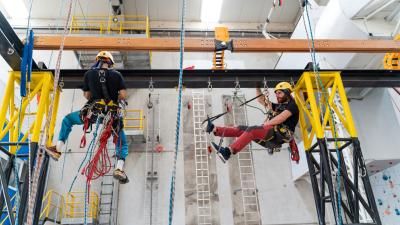What occupational safety and health practitioners need from an evidence centre
This page was published on

We wanted to understand how occupational safety and health (OSH) practitioners in high-risk industries used evidence in their work, and what additional knowledge they considered important to do their jobs well. In this context, a practitioner is someone "who ensures that employees are safe and healthy in the workplace and that employers adhere to safety requirements and standards."
We commissioned researchers at RAND Europe to interview practitioners and ask them about the evidence that they may need from a range of sources, including regulations, data, analysis, expert advice, and peer knowledge. They also explored how practitioners wanted to access this evidence.
We wanted to hear the experience of practitioners who worked in sectors with a "higher incidence of workplace-related accidents, illnesses, and fatalities among workers", including:
agriculture
forestry and fishing
construction
mining and quarrying
transportation and storage
electricity, gas, steam, and air conditioning supply (energy sector)
water supply; sewage; waste management and remediation services
manufacturing
The quick read
The experiences and voices of practitioners are essential to understanding what matters and what works in occupational safety and health (OSH). Evidence is needed to assess these and useful to practitioners in supporting safe and healthy workplaces, especially in high-risk sectors.
In interviews with 29 OSH practitioners from around the world, researchers drew out the following messages:
- Practitioners used their own experience but wanted more evidence.
- There is no single source of accessible but require different types of evidence and standards.
- Evidence can help build cultures of safety, but more evidence is needed to know what makes them effective.
- Practitioners use a wide range of evidence for different purposes.
- There is no single source of accessible and trusted information for practitioners.
- Practitioners need support to access and use evidence.
- The local context matters for access and use evidence.
- Emerging evidence needs to be reliable, especially in relation to climate change and new technologies.
Our new Global Safety Evidence Centre will work with practitioners to ensure that research and insights are as relevant as possible.
Download the briefing

What occupational safety and health practitioners need from an evidence centre (briefing)
This report highlights OSH practitioners' need for accessible, reliable evidence, support in using it, and filling in gaps, especially in high-risk sectors and emerging areas.
Download What occupational safety and health practitioners need from an evidence centre (briefing) (PDF, 2.02MB)Citation (Briefing)
If you wish to use and reference the What occupational safety and health practitioners need from an evidence centre (Briefing) in your own work, please include the following DOI: https://doi.org/10.60743/1qws-7263
Example Citation in IEEE Style:
Lloyd's Register Foundation, “What occupational safety and health practitioners need from an evidence centre (Briefing),” Lloyd's Register Foundation, 2025. doi: 10.60743/1QWS-7263.
Download the technical report

What occupational safety and health practitioners need from an evidence centre (technical report)
This technical report highlights OSH practitioners' need for accessible, reliable evidence, support in using it, and filling gaps, especially in high-risk sectors and emerging areas like AI and climate.
Download What occupational safety and health practitioners need from an evidence centre (technical report) (PDF, 702.88KB)Citation (Technical report)
If you wish to use and reference the What occupational safety and health practitioners need from an evidence centre (Technical report) in your own work, please include the following DOI: https://doi.org/10.60743/q3fq-j679
Example Citation in IEEE Style:
RAND Europe, “What occupational safety and health practitioners need from an evidence centre (Technical report),” Lloyd's Register Foundation, 2025. doi: 10.60743/Q3FQ-J679.